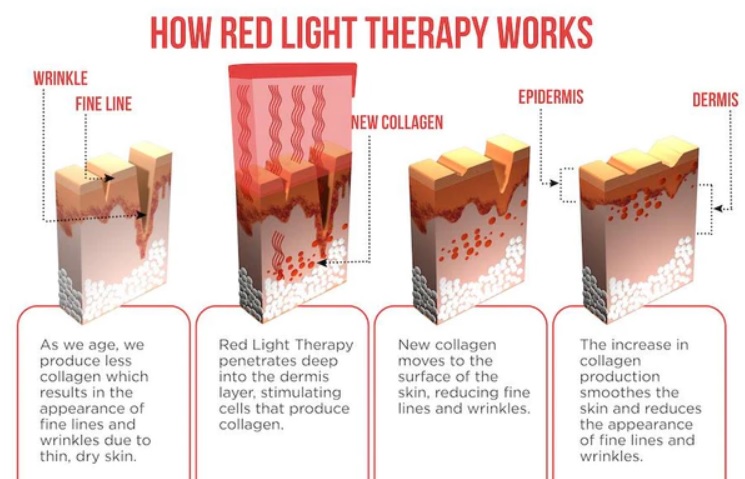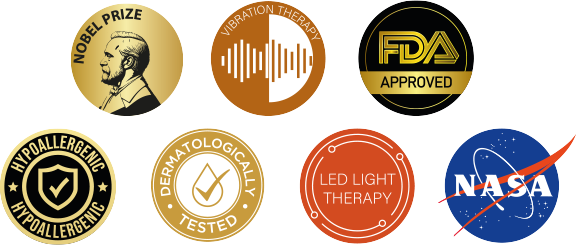
Red and blue light are gaining popularity in both beauty salons and home treatments. Being a FDA approved therapy, LED technology helps in chronic joint pain, slow to heal wounds, wrinkles, hair loss and acne or other issues, like psoriasis, improved circulation and better immune function.
LED light therapy uses various wavelengths including red and blue, Red light therapy is nowadays used in cosmetics, especially against wrinkles; Blue light therapy is used by beauty parlours to cure acne and different skin conditions. Both red and blue LED lights are safe to use daily and for all skin types, these lights do not contains ultraviolet rays and do not cause skin burns.
Red light therapy is also known as photo biomodulation (PBM), low level light therapy (LLLT), bio stimulation, photonic stimulation or light box therapy.
Red light is used to treat the outermost layer of skin, with wavelengths range between 630-880nm, otherwise known as the epidermis, penetrating about 8-10 millimetres into the skin. It is thought that when this layer of skin absorbs infrared light, the fibroblast cells that are responsible for the production of collagen proteins are then stimulated. The increase in collagen production can make the skin look smoother, which can mitigate the appearance of fine lines and wrinkles.
Blue light, on the other hand, targets the oil glands located in the deeper layers of skin. By reducing the amount of oil that these glands produce, the skin can become drier which in turn could lead to fewer acne breakouts.
Blue LED light therapy can target those oil glands and make them less active. Blue light also kills the bacteria causing acne under the skin, which can help in treating serious acne problems, including cysts and nodules.
Blue light is also frequently used in combination with red LED light which helps with acne, heals scars and supports anti-inflammatory effects. According to some studies, blue LED therapy can enhance the healing of third-degree burns.
Here’s a partial list of the evidence-based uses of red therapy light:
It helps rejuvenate facial skin and smooths skin tone.
Red light builds collagen in the skin to reduce wrinkles and fine lines.
It helps to repair sun damage and age spots.
Red light activates the lymphatic system for potentially improved detoxification.
Decreases inflammation in the skin.
Helps fade scars and stretch marks.
Improves hair growth to reverse balding.
Stimulates slow healing wounds.
Can prevent recurring cold sores, or herpes simplex.
Helpful in the short term for carpal tunnel syndrome.
Beneficial for skin to reduce eczema, rosacea, and acne.
A clinical trial in the journal Photomedicine and Laser Surgery https://www.ncbi.nlm.nih.gov/pmc/articles/PMC3926176/ explored light treatment for some basic skin issues in a small group of 136 people. The researchers found that these light therapies could rejuvenate the skin, improve the complexion and improve the feeling of the skin.
- Better Circulation and Collagen Production
When the light penetrates through the epidermal and dermal skin layers, it increases circulation to help form new capillaries. It also increases collagen production and fibroblasts. Red therapy light improves collagen levels naturally by triggering the body to produce more of its own. Since collagen comprises about 70% of the protein in our skin, it’s a big deal!
Red light therapy is thought to work by acting on the “power plant” in your body’s cells called mitochondria. With more energy, other cells can do their work more efficiently, such as repairing skin, boosting new cell growth and enhancing skin rejuvenation. More specifically, certain cells absorb light wavelengths and are stimulated to work.
Red light therapy may work in skin health to:
- Stimulate collagen production, which gives skin its structure, strength and elasticity.
- Increase fibroblast production, which makes collagen. Collagen is a component of connective tissue that builds skin.
- Increase blood circulation to the tissue.
- Reduce inflammation in cells.
Increased collagen doesn’t just give the skin a wrinkle-free glow, but its ability to improve joint health makes it great for arthritis sufferers. It can be helpful for those with a variety of painful musculoskeletal issues. The increased circulation and anti-inflammatory effects that red therapy light provides also help reduce pain and heal the body.
- Wound Healing with Red Light Therapy
Fibroblasts in our skin synthesize collagen, maintain connective tissue and are integral to wound healing. Red therapy light stimulates fibroblasts to do their job, and increases circulation for faster wound repair time. People have also used this therapy for burns, amputation injuries, skin grafts and infected wounds. It’s been successfully used for skin damage caused by cancer treatments, including those in the mouth and mucus membranes.
Anais Brasileiros de Dermatologia ( https://www.ncbi.nlm.nih.gov/pmc/articles/PMC4148276/ ) highlights the fact that light therapy may help wound healing in a few ways, such as by:
- reducing inflammation in the cells
- stimulating new blood vessels to form, which doctors call angiogenesis
- increasing helpful fibroblasts in the skin
- increasing collagen production in the skin
Dentists have also successfully used red therapy lights to heal sores and abrasions in the mucus membranes of the mouth. It’s also been found to prevent recurring cold sores that occur along the mouth.
- A Remedy for Hair Loss
. A 24-week study demonstrated that red therapy light significantly improved hair density and hair thickness without any serious reactions. Participants wore a helmet that emitted red therapy light to achieve this effect.
- Recover Faster from Injury and Illness & Reducing pain
Red light therapy increases circulation and ATP production throughout the body which may help speed healing during times of illness. It also stimulates lymph system activity and phagocytosis, the process of cells cleaning house.
The research indicated that Red Light Therapy could effectively reduce pain in adults with different musculoskeletal disorders. The researchers note that practitioners who stick to the specific dosage recommendations seem to increase the effectiveness of the therapy.
Red light therapy was used by NASA in threatening injuries for US Navy crews. These produced more than a 40 percent greater improvement in musculoskeletal injuries and a 50 percent faster healing time for lacerations. (https://spinoff.nasa.gov/NASA-Research-Illuminates-Medical-Uses-of-Light ).
- Help for the Thyroid
One of the big reasons I started looking into red light therapy is because of the potential for improved thyroid function. There are several compelling studies that look at the benefits of red light and near infrared therapy for thyroid health. As someone who has struggled with Hashimoto’s Thyroiditis, I was interested in trying this kind of therapy.
- A Promising Therapy for Psoriasis
A study published in the journal of Photomedicine and Laser Surgery (https://www.ncbi.nlm.nih.gov/pmc/articles/PMC3926176/ ) found benefits for psoriasis sufferers. Skin plaques improved by 60-100% when treated with both red therapy light and infrared light, like that used in a sauna. The infrared light helped to calm inflammation, while the shorter red wavelengths helped heal the skin’s surface.
- Help for Acne, Rosacea, and Eczema
The collagen and ATP stimulating benefits of red-light therapy make it a promising solution for skin problems like acne, rosacea, and eczema, the first benefits that were noticed after using red light therapy were in reducing stretch marks and wrinkles.
RLT is generally safe and may be a very effective treatment option for people seeking smaller changes in their skin or to keep the skin healthy and reduce inflammation. RLT is only one part of a complete skin care routine, and it should not be the only way a person takes care of their skin. It may take several treatments of RLT for a person to begin noticing the changes in their skin.



